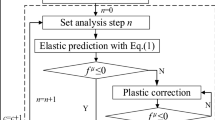Abstract
A common phenomenon of fatigue test data reported in the open literature such as S-N curves exhibits the scatter of points for a group of same specimens under the same loading condition. The reason is well known that the microstructure is different from specimen to specimen even in the same group. Specifically, a fatigue failure process is a multi-scale problem so that a fatigue failure model should have the ability to take the microscopic effect into account. A physically-based trans-scale crack model is established and the analytical solution is obtained by coupling the micro- and macro-scale. Obtained is the trans-scale stress intensity factor as well as the trans-scale strain energy density (SED) factor. By taking this trans-scale SEDF as a key controlling parameter for the fatigue crack propagation from micro- to macro-scale, a trans-scale fatigue crack growth model is proposed in this work which can reflect the microscopic effect and scale transition in a fatigue process. The fatigue test data of aluminum alloy LY12 plate specimens is chosen to check the model. Two S-N experimental curves for cyclic stress ratio R=0.02 and R=0.6 are selected. The scattering test data points and two S-N curves for both R=0.02 and R=0.6 are exactly re-produced by application of the proposed model. It is demonstrated that the proposed model is able to reflect the multiscaling effect in a fatigue process. The result also shows that the microscopic effect has a pronounced influence on the fatigue life of specimens.
Similar content being viewed by others
References
Miner M A. Cumulative damage in fatigue. J Appl Mech, 1945, 12(3): A159–A164
Paris P C. The growth of cracks due to variations in load. Dissertation for the Doctoral Degree. Bethlehem: Lehigh University, USA, 1962
Sih G C. Multiscaling in Molecular and Continuum Mechanics: Interaction of Time and Size from Macro to Nano. Berlin: Springer, 2006
Sih G C. Multiscale Fatigue Crack Initiation and Propagation of Engineering Materials: Structural Integrity and Microstructural Worthiness. Berlin: Springer, 2008
Jones R, Caims K, Baker J, et al. A study of the effect of CPCs on fatigue crack propagation in a representative fuselage lap joint specimen. Eng Fract Mech, 2012, 87: 1–82
Benedetti M, Fontanari V, Santus C, et al. Notch fatigue behaviour of shot peened high-strength aluminum alloys: Experiments and predictions using a critical distance method. Int J Fatigue, 2010, 32: 1600–1611
Schmidt F, Rheinfurth M, Horst P, et al. Multiaxial fatigue behaviour of GFRP with evenly distributed or accumulated voids monitored by various NDT methodologies. Int J Fatigue, 2012, 43: 207–216
Ma Y E, Staron P, Fischer T, et al. Size effects on residual stress and fatigue crack growth in friction stir welded 2195-T8 aluminum-Part I: Experiments. Int J Fatigue, 2011, 33: 1417–1425
Hong Y S, Zhao A G, Qian G A, et al. Fatigue strength and crack initiation mechanism of very-high-cycle fatigue for low alloy steels. Metall Mater Trans A, 2012, 43: 2753–2762
Sun C, Lei Z, Xie J, et al. Effects of inclusion size and stress ratio on fatigue strength for high-strength steels with fish-eye mode failure. Int J Fatigue, 2013, 48: 19–27
Zeng R C, Han E H, Ke W, et al. Influence of microstructure on tensile properties and fatigue crack growth in extruded magnesium alloy AM60. Int J Fatigue, 2010, 32: 411–419
Jang C H, Cho P Y, Kim M, et al. Effects of microstructure and residual stress on fatigue crack growth of stainless steel narrow gap welds. Mater Design, 2010, 31: 1862–1870
Bernarda J D, Jordonb J B, Lugo M, et al. Observations and modeling of the small fatigue crack behavior of an extruded AZ61 magnesium alloy. Int J Fatigue, 2013, 52: 20–29
Ghonem H. Microstructure and fatigue crack growth mechanisms in high temperature titanium alloys. Int J Fatigue, 2010, 32: 1448–1460
Vipul K G, Richard P G, Sean R A. Diffraction characterization of microstructure scale fatigue crack growth in a modern Al-Zn-Mg-Cu alloy. Int J Fatigue, 2012, 42: 131–146
Sih G C, Tang X S. Dual scaling damage model associated with weak singularity for macro-scopic crack possessing a micro-/meso-scopic notch tip. Theor Appl Fract Mech, 2004, 42: 1–24
Tang X S, Sih G C. Weak and strong singularities reflecting multiscale damage: micro-boundary conditions for free-free, fixed-fixed and free-fixed constraints. Theor Appl Fract Mech, 2005, 43: 5–62
Sih G C, Tang X S. Simultaneous occurrence of double micro/macro stress singularities for multiscale crack model. Theor Appl Fract Mech, 2006, 46: 87–104
Sih G C, Tang X S. Asymptotic micro-stress field dependency on mixed boundary conditions dictated by micro-structural asymmetry; Mode I macro-stress loading. Theor Appl Fract Mech, 2006, 46: 1–14
Tang X S, Sih G C. Equilibrium mechanics model of multiscaling by segmentation: asymptotic solution for macro-meso-micro damage in anti-plane shear deformation. Theor Appl Fract Mech, 2005, 44: 1–15
Sih G C, Tang X S. Triple scale segmentation of non-equilibrium system simulated by macro-micro-atomic line model with mesoscopic transitions. Theor Appl Fract Mech, 2005, 44: 116–145
Sih G C, Tang X S. Form-invariant representation of fatigue crack growth rate enabling linearization of multiscale data. Theor Appl Fract Mech, 2007, 47: 1–14
Editorial Board. Practical Handbook of Engineering Materials (Vol. 3) (In Chinese). Beijing: Chinese Standard Press, 1988. 92–144
Author information
Authors and Affiliations
Corresponding author
Rights and permissions
About this article
Cite this article
Tang, X. Scatter of fatigue data owing to material microscopic effects. Sci. China Phys. Mech. Astron. 57, 90–97 (2014). https://doi.org/10.1007/s11433-013-5333-9
Received:
Accepted:
Published:
Issue Date:
DOI: https://doi.org/10.1007/s11433-013-5333-9




